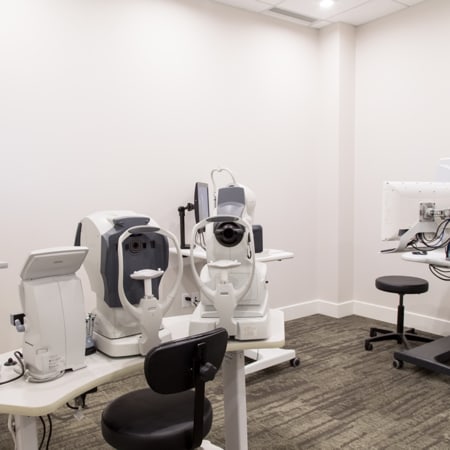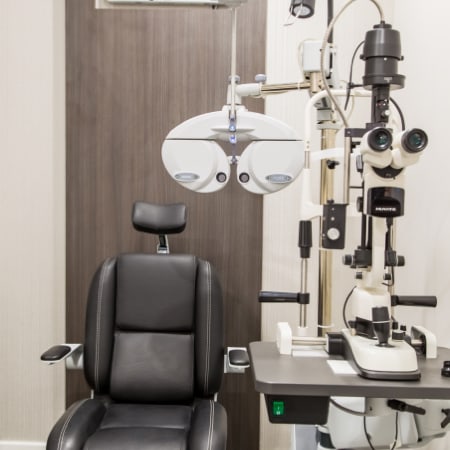Diabetes is a common disease in the United States and Canada, and furthermore, diabetic eye disease is the most common cause of blindness in the US. Regular eye examinations are important in diabetes because diabetic eye disease and the vision loss caused by it are completely preventable.
In diabetes, high sugar levels in the blood damage blood vessels throughout the entire body. Damage to blood vessels in the kidneys can cause kidney failure; damage to blood vessels in nerves can cause neuropathy; damage to the blood vessels in your eyes can cause blindness.
In particular, high blood glucose levels cause damage to the blood vessels in the retina of the eye. The retina lines the back of your eye like wallpaper, and acts like the film in a camera — it detects the light entering your eye and turns it into pictures for your brain to see. When the retina’s blood vessels are damaged, the retina stops working properly, and sight can be lost.
*Normal Vision on the left and same scene with diabetic retinopathy on the right*
After being exposed to high sugar levels for a long time, the blood vessels in the retina develop some weak spots. These weak spots often bulge out like bubbles along the blood vessels – these are called microaneurysms. Sometimes the microaneurysms can rupture, and blood spills into the retina to form small dot hemorrhages. Your retina will eventually clear the blood away, but some debris is often left behind—these clumps of debris are called hard exudates. Altogether, these changes (microaneurysms, dot hemorrhages, and hard exudates) collectively form something called background diabetic eye disease.
The greatest risk factor for background diabetic eye disease is the length of time one has had diabetes. Most people with diabetes get these small changes in their eyes after having diabetes for five years or more. Background diabetic eye disease does not usually cause significant vision loss unless the swelling occurs in the very center part of the retina, called the macula. If you have swelling here, it is called diabetic macular swelling( or macular edema), and it is a common cause of vision loss among diabetic patients.
Background diabetic retinopathy is a sign that your retina’s blood vessels are sick. If enough of the blood vessels rupture, the retina may not receive and distribute enough blood to keep it healthy. In this case, the retina will try to grow new blood vessels to replace the sick ones. Unfortunately, these new blood vessels usually grow in the wrong places. They are fragile, and they break easily, sometimes spilling enough blood to fill up pockets of blood in the eye. When these new blood vessels begin to grow, it is called proliferative diabetic eye disease.
Proliferative diabetic eye disease is less common than background diabetic eye disease, but is much more likely to take away some or all of your vision. If it is caught early, before your vision is damaged, proliferative diabetic eye disease can be treated with laser therapy to save your vision. Once the vision is lost, it is very hard to get it back.
Background and early proliferative diabetic retinopathy have no symptoms. The only way to know if you have these changes, and possibly require treatment, is to visit your optometrist regularly. People with diabetes should have their eyes examined at least once a year to make sure they do not have early damage that threatens their sight. Because you have been diagnosed with diabetes, these exams are covered by OHIP and will be no cost to you. We do, however, highly recommend having retinal photography taken each year to monitor any changes in the retina due to the diabetes and other potential conditions. This has a small fee but is very important to managing your condition.
How can I prevent getting Diabetic Retinopathy?
Retinopathy affects 23% of people with type 1 diabetes and 14% of people with type 2 diabetes on insulin therapy. The good news is that there are steps you can take to catch this complication early and prevent its progress:
-Visit your CAO optometrist at least once per year. Your optometrist may recommend you visit more or less frequently depending on your situation.
– Maintain optimal blood glucose levels, blood pressure and blood cholesterol.
-Know your A1C (a test of your average blood glucose level over three months). Most people with diabetes should aim for a target of 7.0 or less. Talk to your healthcare team about what your target should be.
You sight is an important part of your life. Please do not take it for granted. Get your eyes examined yearly.
by Dr. Wesdon McCann















